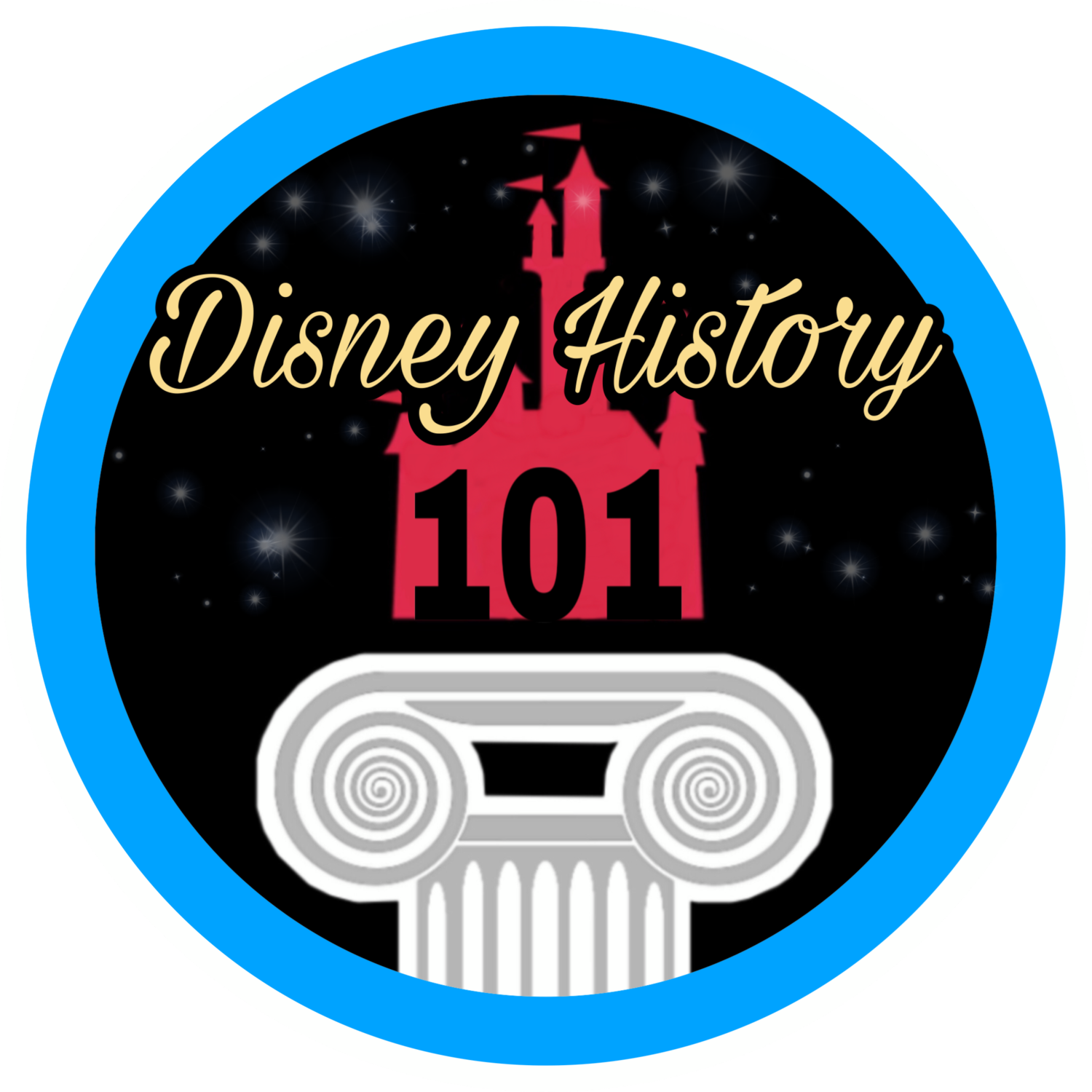DISNEYLAND CITY HALL
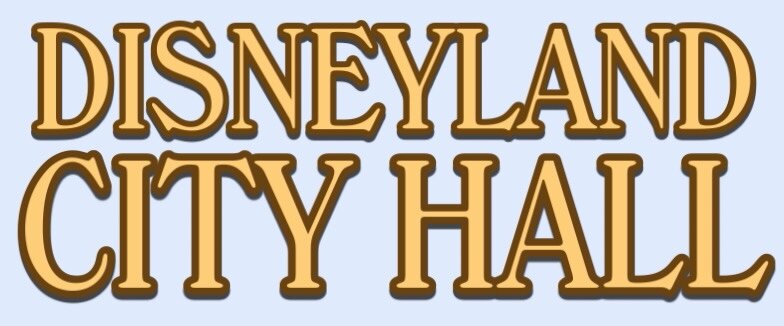
(July 17, 1955 - present)
“Blue Sky for Disneyland City Hall”
Since the earliest planning phases of Disneyland Park, drawings included a civic center and buildings. These early thumbnail sketches and other concept artwork seemed to be unencumbered by restrictions of budget, schedule or the laws of nature and physics. Though guided by Walt, his artists appeared to engage in “free-thinking,” as if implementing the modern “Blue Sky” Imagineering process. The “Proposed Diagramatic Layout of Disneyland” (Marvin A. Davis’ plot plan, produced for WED Enterprises, Inc. by September 12, 1953) detailed “Town Hall” on the East side of “Main Street.” At that time, Herb Ryman’s “Schematic Aerial View” of Disneyland (originally produced September 26 & 27, 1953) also depicted a City Hall structure in that civic center. One year later, “The Disneyland Story” (a document produced for WED Enterprises, Inc., September 3, 1954) mentioned “you find yourself in a Civic Center or Town Square at the Turn of the Century… here you will see the Town Hall.”

A civic center is labeled on “Disneyland Preliminary Scheme #1”.
Around this time, artist Harper Goff had already been tasked with creating concepts of the turn-of-the-century Main Street facades. The preliminary designs of Disneyland City Hall was partially inspired by a building from Harper Goff’s hometown of Fort Collins, Colorado and the Bay County Courthouse of Bay City, Michigan. Like some advanced “High Concept,” final designs were quickly generated and approved.
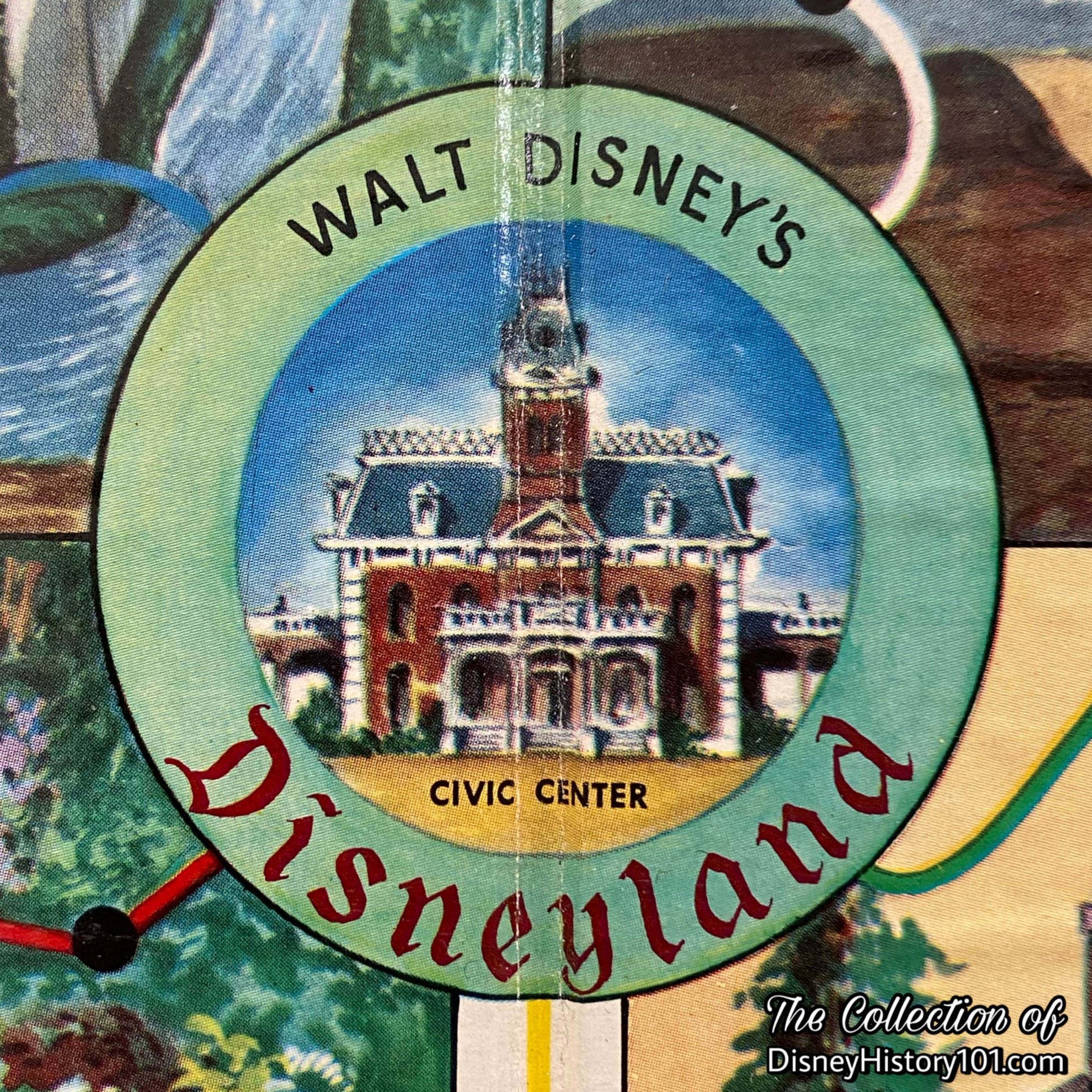
The "Civic Center" is depicted on a game board.
Early merchandise gave a preview of Disneyland City Hall, before construction even began.

“200 Block Town Hall Elevations” drawn by Lorrecc, January 7, 1955; revised by RAM 3-4-55 & E. Jericho, 3-19-55; checked by WBK
“Architectural Plans”
Next, architectural drawings helped define all designs, production and construction strategies, costs, schedule, and resource requirements. “Disneyland is unique in that some of the world's foremost creative artists and architects control all design at Disneyland.“ Models explored the various dimensional relationships, site-lines, flow patterns, ergonomics, and visual appeal to convey the desired creative intent.
By January 7, 1955, architectural drawings (elevations and site plans) for “Town Hall” on the 200 Block had been completed by a “Lorrecc” and an “H.S.” of WED Enterprises, Inc. for Disneyland, Inc. The drawings were checked by a “WBK,” approved by two individuals, and revised twice - by “R.A.M.” (on March 4, 1955) and E. Jericho (March 9, 1955). These were working (construction) drawings and were the final plans from which the facilities were built.
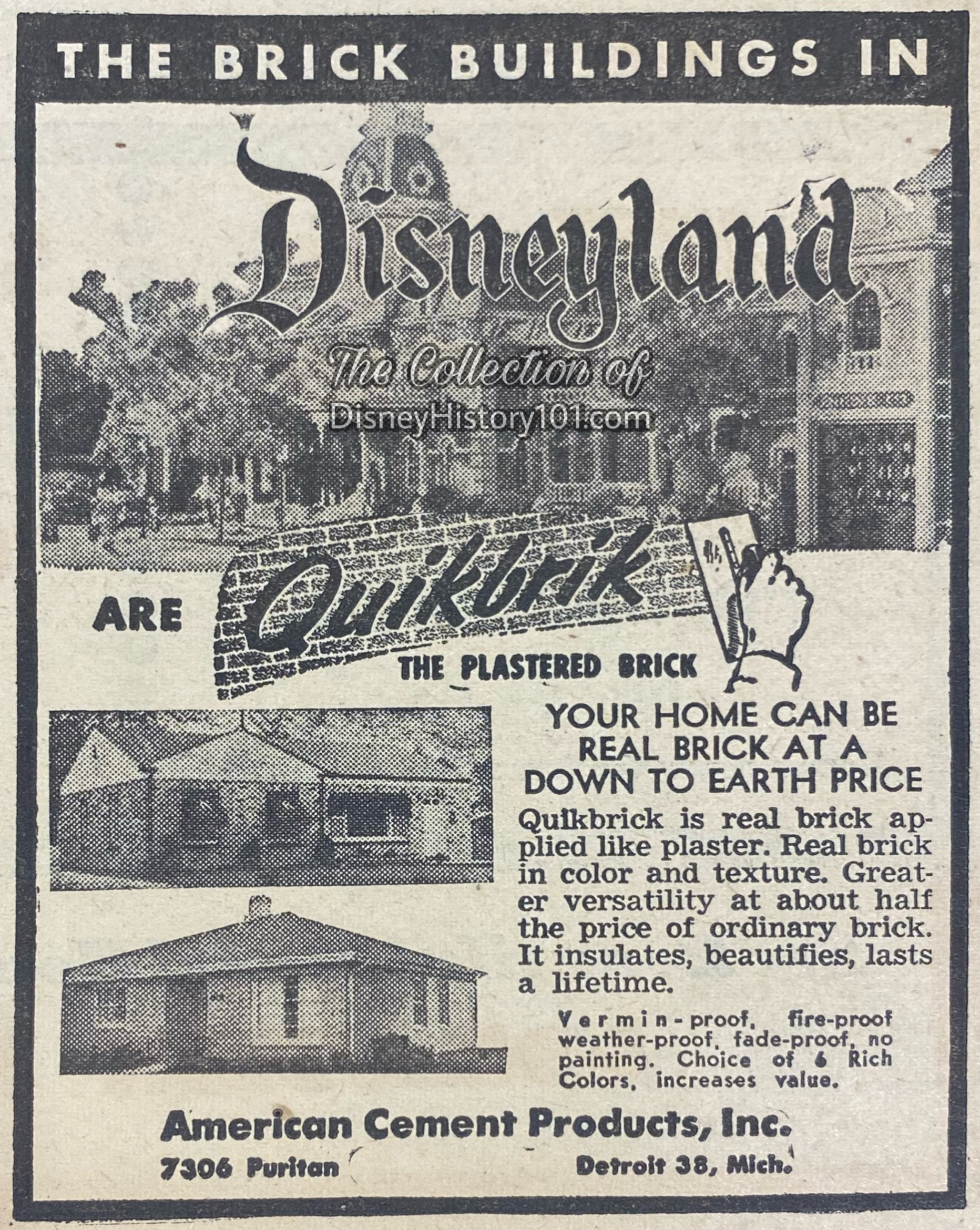
“Construction”
F. M. Franz, manager of operations for MeNeil Construction expressed: “We feel sure there has never been anything built like this in Southern California, or elsewhere in the United States. Many of the items were constructed from artist’s sketches.”
“Foundations and Framing”
First, a concrete foundation and slab floors were prepared, followed by wood frame construction (while store units would have a combination wood and rigid steel frame). On Main Street U.S.A., the buildings would not be full scale. Ground floors were built about 9/10ths scale. Second floors measured up to 7/10ths scale. The scale on the uppermost floors would be smaller still. Forced perspective would only make the buildings on Main Street appear taller than actually are. Still, the final steel and wood frame of Disneyland City Hall (though at a charming 5/8 scale) was actually more “to scale” than other structures on Main Street.
“Electrical, Plumbing, Air Condition Installation”
“Newbery Electric Corp. took the rapid electrical construction of Disneyland in stride. The electrical installations were supervised by Roy J. Gruendler, manager of Newbery's Orange County district office located at 1335 Santiago Ave, Santa Ana.”
Disneyland City Hall was also serviced by an air conditioning system and possessed complete fire sprinkling systems. By June 30, 1955, related Disneyland Site Work Fire Protection Utilities Plot Plans were prepared for Disneyland Inc., by J.E. Thomasson of WED Enterprises Inc.
“Drywall and Floors”
The rooms had asphalt tile floors, and painted and papered drywall partitions and ceilings.
“Brickwork”
The exterior also has 1,000 square feet of covered porches and steps. Much of the “brick” of Main Street Architectural Facade was QuikBrik “real brick applied like plaster,” manufactured by American Cement Products, Inc. (of Detroit, Michigan). Larson Brothers Plastering Company of San Diego was a proud part of Disneyland. The company crafted the ornamental plastering and all brick used at Disneyland (including their amazing new plastered brick veneer). The versatile Quikbrick (real colorful and textural brick applied like plaster) was about half the price of ordinary brick. It insulated, beautified, and was meant to “last a lifetime.” It was used on the facade. Scenes of plasterers carving these “brick” facades on Main Street are seen in a few brief scenes of A Pre-Opening Report from Disneyland.
“Roofing”
According to inserts published in area newspapers during July of 1955, Disney buildings were roofed by Pioneer Roof & Shingle Company (then located at 608 Mateo Street, Los Angeles, California; 7522 Westminster Avenue, Westminster, California). Many roof coverings were a variable, dependent on the architectural design. The roof of City Hall was a steep wood shingle roof with dormers, towers, and ornamental iron railings.
“Storytelling Set - Decorative Fixtures”
All fixtures were placed in their correct motif and many light fixtures of Disneyland were authentic antiques. By July 2, 1955, shadow gags were ordered. Painted signs, window, curtains, and shades were projected to be completed on time. The sound equipment was be installed, with completion of the tape recordings appearing to be fairly tight.
On June 2, 1955, C.V. Wood Jr. sent an Inter-Office Memorandum to Walt Disney regarding the best estimates that could be obtained at the time regarding the status of individual sections of the Park and Opening Day. C.V. wrote: “The City Hall - It will be complete… Police Station - This and the Lost Children’s Play Ground behind it will be complete.”
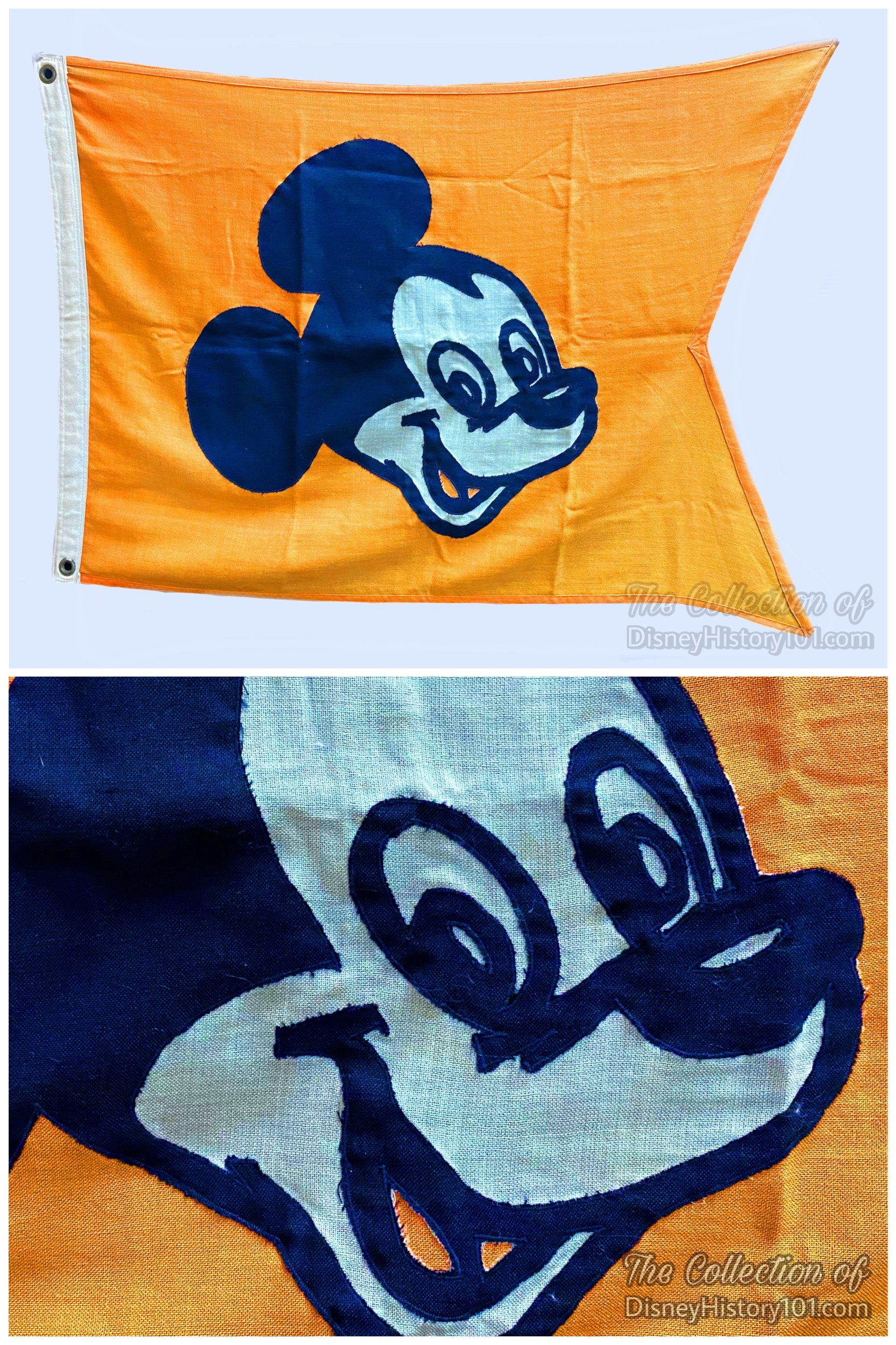
The Mickey Mouse Flag, which was flown over Disneyland City Hall, the Main Street Station, Guest Relations, the Disneyland Fire Department, and even “the Biggest Bass Drum” in the world.
“The Mickey Mouse Flag”
The first Disneyland Dictionary (printed October 1959) makes a brief (but noted) distinction between the Mickey Mouse Flag and the “Official Flag of Disneyland”: “There are many flags flown in Disneyland - atop buildings, flag poles and many of Disneyland's boats. There are American flags of today and flags of our nation's historical growth, and flags of other countries. There are also Mickey Mouse flags and the official Disneyland flag.”
Several styles of flags are typically flown atop Disneyland City Hall including a 45-star American Flag (in keeping with the turn-of-the-century era) and a Mickey Mouse Flag (over the Police Department).
The Mickey Mouse Flags were copyright Walt Disney Productions and once located over Main Street Depot, the Police Station, the Fire Station, and the Mickey Mouse Club Theater. These were a reminder “for all who come to this happy place,” that “it all started with a mouse.”

The Official Disneyland Flag.
“The Official Flag of Disneyland”
Another important flag was the Official Flag of Disneyland, a copyright Walt Disney Product and a unique flag that was located exclusively over the Main Street Depot and above Disneyland City Hall. For a time, this flag was manufactured by Hortie-Van Banner. & Flags of Pasadena (est. 1926). There have been at least four styles of this flag - two rectangle styles (one with the full name “Disneyland”; the other with the “D” monogram) and two styles of swallowtail flags (a short and a long).

Disneyland City Hall Construction; April-May of 1955.
“Pre-Opening Operations at Disneyland City Hall”
Disneyland City Hall is one of the oldest buildings in Disneyland, as construction began with Town Square. Day Sechler recalled: “When I first saw Disneyland, the only thing was the four-foot high walls of the City Hall!“ Even while construction of Disneyland was ongoing, Bob Thomas (of Associated Press) visited for a tour with Walt Disney. “‘That will be the City Hall over there,’ he said, pointing to a construction on the West Side. ‘We’ll have our offices there and a press room upstairs.’”
Very early on, Disneyland City Hall became a functioning civic center of the site. The upper floors were used as the Disneyland Operations office even before Disneyland opened, and it was also used as the Disneyland Publicity Office for press-related work (source of “News From Disneyland.” This office was ideal for Eddie Meck as “he could greet the press ... and see the guests,” according to the recollection of Van France (of the University of Disneyland). From this location, Eddie began to sell Disneyland to the world! Sometime after May 17, 1955, WED Enterprises, Inc. staff like G. Scognamillo, George Patrick, Dick Irvine, Bill Martin, and Wade Rubottom moved to “the site” and set up offices in the upper floor of the City Hall through opening.
Eventually, one authorized “Disneyland Information & Nomenclature List” (prepared by Bill Cottrell of Disneyland Inc., by May 25, 1955) listed “official and authorized nomenclature” of Disneyland, and even distinguished the “Buildings in Civic Center” : “Disneyland Police Department, Disneyland City Hall, Disneyland Fire Department, Disneyland Opera House.”

In front of City Hall are copies of durable Rochester Chairs.
“Press Preview Day”
Soon (on July 17, 1955), Bob Cummings first introduced Disneyland City Hall this way : “There’s City Hall - quaint and dignified, with its Post Office! The place where the citizens of the town gather to exchange gossip and hear the latest news of the day.”
“General Information”
Since 1955, Disneyland City Hall has been synonymous with General Information! Here, at Disneyland City Hall was Disneyland’s "Guest Relations Office” behind the information desk, where Guests could receive general Information about Disneyland, from Cast Members were familiar with the parks as a Guest and were able to answer guest’s questions. There was no “stupid” question and every Guest was entitled to his or her opinion. In addition, information about bus and helicopter schedules, and motel and trailer park information could also be obtained at the City Hall on Main Street.
According to the Guided Tour Script (published, 1962), “The large brick building across Town Square is Disneyland’s City Hall. If you have any problems you may take them there, because we all know, City Hall has ALL the answers.”

Disneyland City Hall Staff goes out of their way to help that “lost parent” and his child.
“Lost Children Department”
In 1956, benches adjacent to signs which read “Inquire Here for Lost Parents” (in locations like the Central Plaza Hub) helped lost family members reunite. [This can be seen in a few scenes of the short film “Disneyland - The Park” (a Disneyland anthology television series short film, originally aired in 1957). Disneylanders were instructed that “Young children must be carefully watched as they easily wander away from their parents… If the parents are not found in a few minutes take the child to First Aid.”
Disneyland City Hall contained the Lost Parent Department, a division of the Disneyland Safety Department. It was also a place where parents could inquire of Lost Children and be reunited with them, and children could claim their lost parents. According to one source : “Kids from one to 100 wander away from each other, and it’s hard to figure out who actually gets lost in the process - parent or child? The problem is being handled through a department known as ‘Lost Children,’ and referred to, by a sign posted at Disneyland City Hall as ‘Lost Parents.’ Located just off Main Street U.S.A., next to the First Aid Offices, it serves as a meeting place for parents and children alike when either becomes lost or misplaced in the busy Anaheim park. Disneyland employees are well briefed on looking out for the lost and to lend a guiding hand when help is needed. On one unusual day a ticket seller reported having twelve children in her tiny booth at one time, all waiting for security guards to pick them up.”
“Actually some children seem to enjoy being lost at Disneyland. And for good reason.” As far back as July 1955, it was “staffed by experienced attendants who maintain a special playground for youngsters,” according to “Welcome to Disneyland,” 1955. As of June 2, 1955, C.V. Wood Jr. sent an Inter-Office Memorandum to Walt Disney mentioning an rarely-talked-about feature of the facility: “The Lost Children’s Play Ground.” By July 1955, it was “staffed by experienced attendants who maintain a special playground for youngsters,” according to “Welcome to Disneyland,” 1955. Attention was drawn to this radical amusement center feature in one photograph of Actress Spring Byington (of “December Bride) and child actor Bobby Diamond (of “Fury”) shot for their 1956 “TV Radio Mirror” article, where the duo are featured taking a little lost boy bye the hand, and leading him “to Lost Children Headquarters - and his folks!”
Upon the grand opening, the Lost Children Department had “colorful benches and tables to play on. Merchandising supplies toys and comic books. And occasionally, a balloon salesman drops by with a few free helium filled models for the gang. Under the faithful eyes of a Matron who stays on duty at all times, the kids are almost too well taken care of.
Len Jones, safety manager in charge of Central First Aid and Lost Children, says ‘St. Patrick’s Day is usually the worst of all. It was last year, we registered over 500 Lost Children and more than 300 more were recovered by their parents before we could get their names into the book.’
When a child is brought in, the matron-in-charge attempts to get as much information as possible, especially the parents’ names. Usually mom and dad are found quite readily. If the missing youngster isn’t claimed in, say two hours, Security is called into the case.
‘On occasion, panic-stricken parents from out of town have returned to their nearby hotel rooms to find their son or daughter safe and sound, just a little exhausted from the day at Disneyland,’ says the head nurse Mary Gilbert.
The maximum age for assistance is ten. If a child older than that loses his parents, he is allowed to wander through the Park, provided he has tickets or money, and is instructed to return to Lost Children in half an hour, whereupon he quite possibly will find his lost parents waiting among the comic books.”
In the present, a sign reading “Lost Parents Inquire Here for Children” features Mr. and Mrs. Darling (whose children temporarily became “lost” with the Lost Boys” of Neverland).


Possibly Ronnie Schueller of Customer Relations (left) at Disneyland City Hall Front of House.
“Other Services”
According to the early souvenir book “A Complete Guide To Disneyland” (published 1956), also mentioned a “First Aid Station.” Other services included Rest Rooms, and public telephones.
Decades later, Disneyland City Hall was also one of several locations where guests could acquire stamps to mail souvenir post cards. By 1987, Disney Dollars (the official currency of Disneyland, available in $1 and $5 denominations) were redeemable for their equivalent U.S. currency at (not Bank of America, but) Disneyland City Hall. This was unique at the time as so many non-Disneyland Disney locations, i.e., Walt Disney World, Glendale Galleria, did not accept Disney Dollars.

(July 17, 1955 - )
Back in 1948, Walt was dreaming about a Park (to be located across the street from the Studio in Burbank). The opening words of the “Mickey Mouse Park” prospectus mentioned that “adjoining Town Hall will be the Fire and Police Stations… The Police Station will be put to practical use. Here the visitors will report all violations… lost articles… lost kids, etc. In it we could have a little jail where kids could look in. We might even have some characters in it.” [“The Spirit of Disneyland”]
Ultimately, Town Square became the civic center of Disneyland, where a number of important structures represented elements of the average turn-of-the-century town. Adjacent to Disneyland City Hall, the Police Station was a free exhibit, giving guests a look at a typical turn-of-the-century jail house. “The Story of Disneyland” [published 1955 by Disneyland Inc.] made mention of “the City Hall and Police Station” exhibit which also served as a “Lost Children” center.

Disneyland Police Department Next-door to Disneyland City Hall, (July 17, 1955 - )
Adjacent to Disneyland City Hall, the Police Station featured a turn-of-the-century jail house. Like the Upjohn Pharmacy or Yale & Town Lock Shop, this was a free exhibit, but it no doubt deterred some would-be shoplifters entering Disneyland’s tunnels. Unbeknownst to most guests, behind the Police Station (in the Backstage area), was an employee Lounge.

The Police Exhibit on the Disneyland Map, c. 1960s.
The first civic center structure that guests encountered through the tunnels was the Disneyland Police Station (located just south of Disneyland City Hall).

The former Police Exhibit on the Disneyland Map, c. 1960s.

The Guided Tours Department was also a great place for Tour Groups to meet.
“The Guest Relations Department”
The Guest Relations Department was formed during 1959. Since then, Disneyland Tour Guides would assist with Guest Relations from Disneyland City Hall. In addition to answering telephone calls that would come into Disneyland, the Guest Relations Department would come to be responsible for “complimentary ticket registrations, the Lost and Found, Carefree Corner, and City Hall locations, and a variety of special events that occur throughout the year. Guest Relations also works very closely with WED, the Press, and Community Affairs”, according to Disneyland LINE Vol. 13, No. 3 (published January 22, 1981). In recent decades, Disneyland City Hall Records (of Disneyland recipes, or names of plants, flowers and trees are available to the public.

Disneyland Audio Amplifier, 1960s-1970s.
“Back of House”
The 4,875 square foot interior contained fourteen offices and adequate restroom facilities. Marty Sklar (Public Relations), Tommy Walker and Ben Harris (assistant to Disneyland Entertainment Director Tommy Walker) once had their Production Department Offices on the 2nd floor of Disneyland City Hall. The upper floors are believed by some to have possibly once temporarily housed the Disneyland PBX Offices (while these were assuredly located on the second floor of the Main Street Opera House).
Sound and music are essential to any spectacular show, and the responsibility for maintaining high quality sound at Disneyland falls to the SOUND DEPARTMENT. An attic on the third floor of Disneyland City Hall once housed computers which controlled some of the sound-related show systems for Main Street U.S.A.
Behind the Police Station (in the Backstage area), was an employee Lounge.
“Special Events on The Disneyland City Hall Stage”
Disneyland City Hall has become a stage for winter holiday celebrations. Beginning in 1955, Disneyland City Hall was decorated for the first Christmas - draped in overhead evergreen wreaths. More than a decade later, the City Hall Balcony was utilized as an “Announcer Location” for Holiday Festivals and Parades of Disneyland’s “First Fabulous Decade.” City Hall was also the setting of a Look Magazine photo shoot (in conjunction with new Disneyland 3-D post cards) on May 24, 1966. The steps of Disneyland City Hall were used as a Stage for performances, as when the Disneyland Christmas Carolers (under the direction of Dr. Charles C. Hirt and lead by Mr. Robert G. Hasty), appeared during various times of the day, from December 16th, 1967 thru January 1st, 1968. [“Disneyland Holiday Talent Master Schedule,” prepared for the period of December 16, 1967 through January 1, 1968]
City Hall was utilized for ceremonies, as when Elsa Marquez (the 1-millionth visitor) stepped through the Disneyland Main Gate. Here (from the steps), Jack Sayers (of Customer Relations) “introduced the Marquez family to Sheriff Bill Lacy of Frontierland, Chief Shooting Star of the Indian Village in Frontierland ; TWA hostess, Jo Ann Weidman ; and K-7 John Catone, the ‘Spaceman’ of Tomorrowland. Following the public announcement and introductions at City Hall, Elsa was showered with gifts from Disneyland and Disneyland exhibitors,” according to one newspaper article.
Many celebrities have made appearances at Disneyland City Hall. Among notable VIPs was the comedic Milton Berle inquiring about “lost child” Jerry Lewis. “55er” Frank Martines recalled: “One time Jimmy Stewart got cornered by the fans near City Hall. I'll never forget watching him run across the parking lot, trying to get away!” On another occassion, on a Sunday morning in 1959, Senator (and United States Presidential Candidate) John F. Kennedy and Guinea President Ahmed Sekou Toure met (and were photographed) at Disneyland City Hall.

Disneyland City Hall, 1955.
Those tall Eucalyptus trees behind City Hall, were present in the groves countless years before Disneyland construction began. You see, they were originally utilized as a “wind break” for the orange trees that once grew on the land. Another similar group of trees would be retained near the site of the Casey Junior Circus Train in Fantasyland. Today the landscaping partially functions as frost control and to screen service areas.

Disneyland City Hall, August 4th, 1955.

Disneyland City Hall; 1955.

Disneyland Town Square

Disneyland City Hall

Disneyland City Hall

Disneyland City Hall; February, 1958.
Near City Hall, was a posted sign listing the day’s entertainment (Disneyland Marching Band, Frontierland Indians, and “Gonzalez, Gonzalez, and Gonzales”)!

Disneyland City Hall

Disneyland City Hall at Night

Disneyland City Hall, (October, 1967)
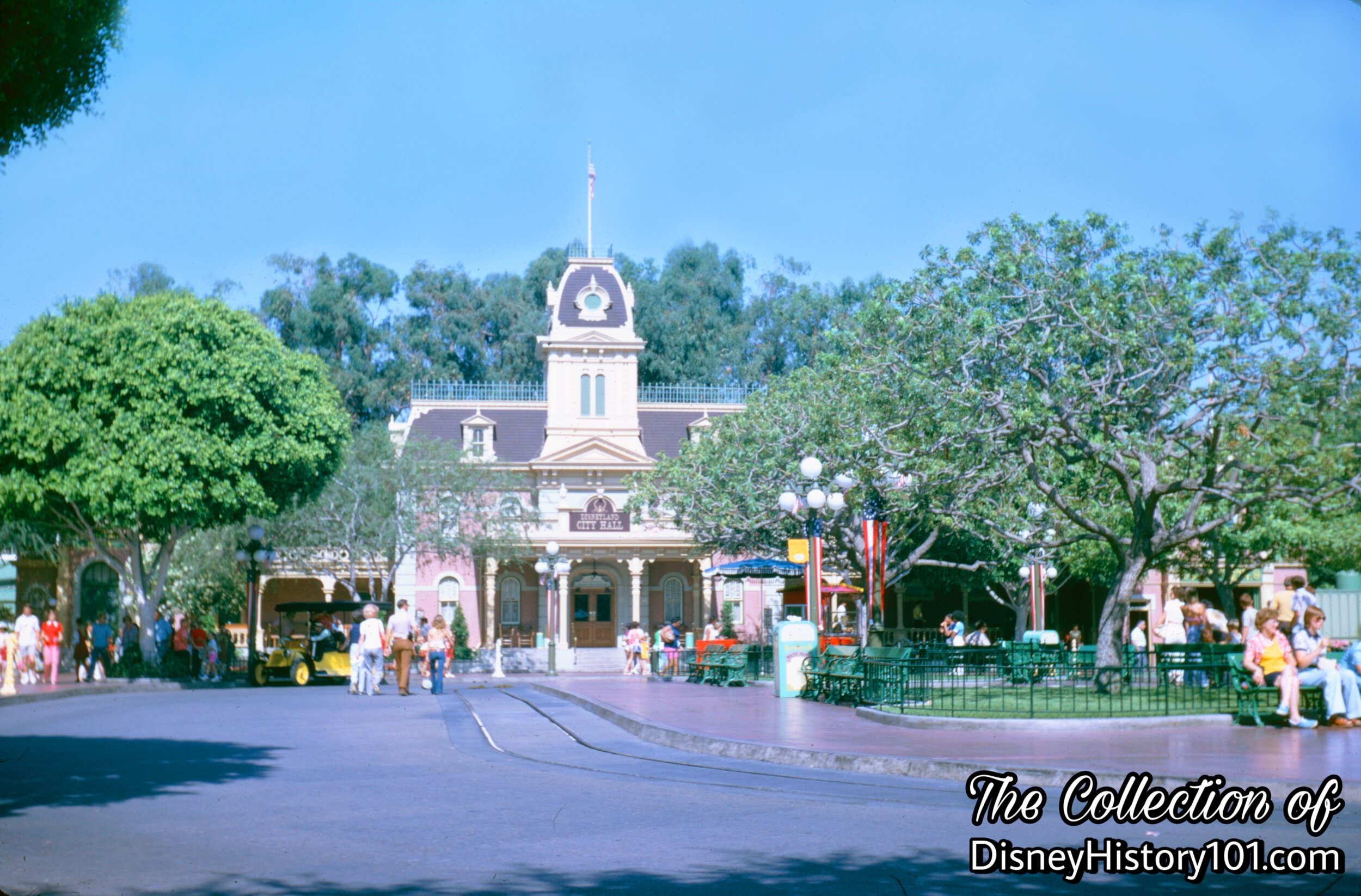
Disneyland City Hall

Disneyland City Hall, (April, 1963)

Disneyland City Hall, (1960)
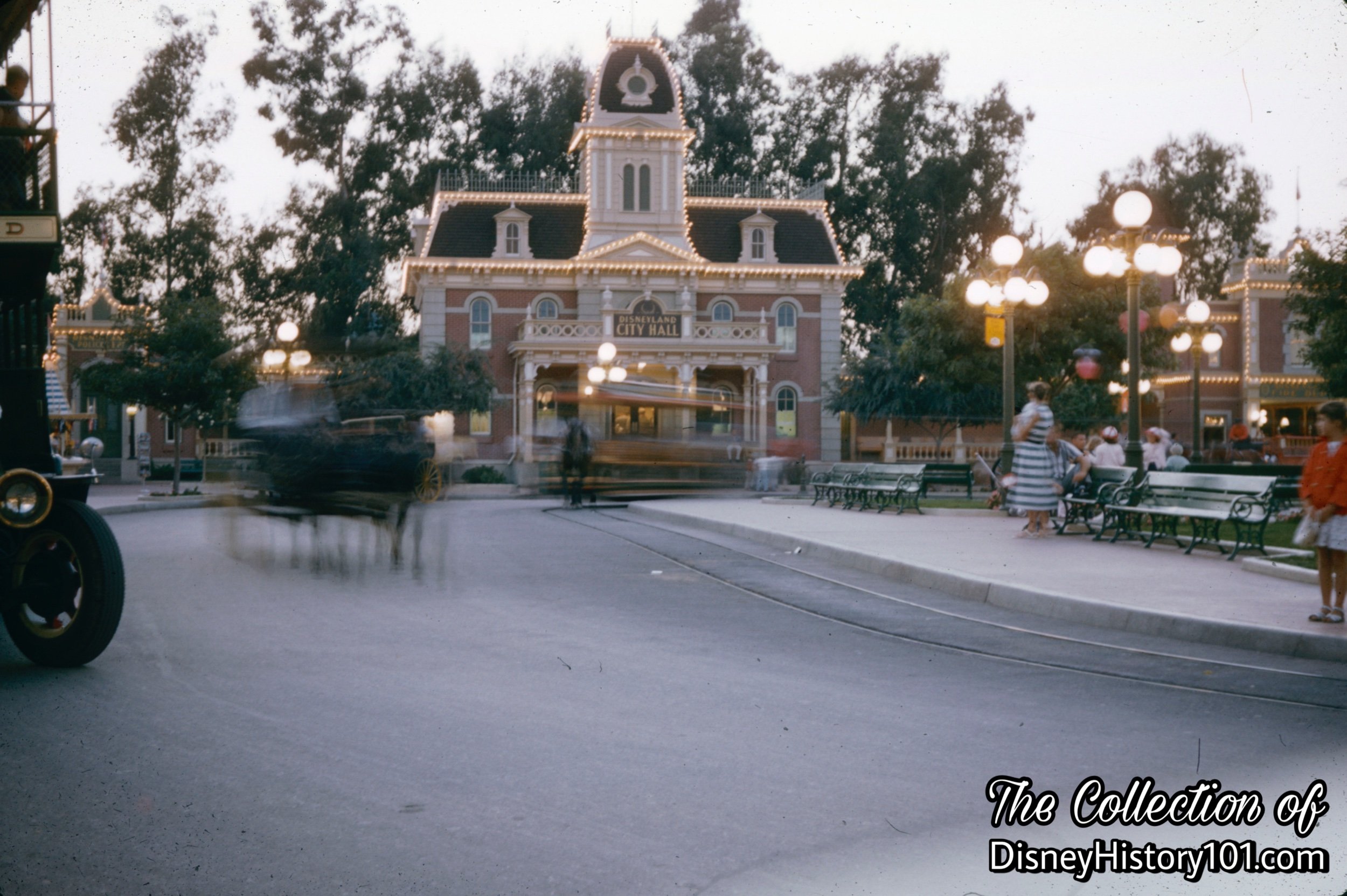
Disneyland City Hall
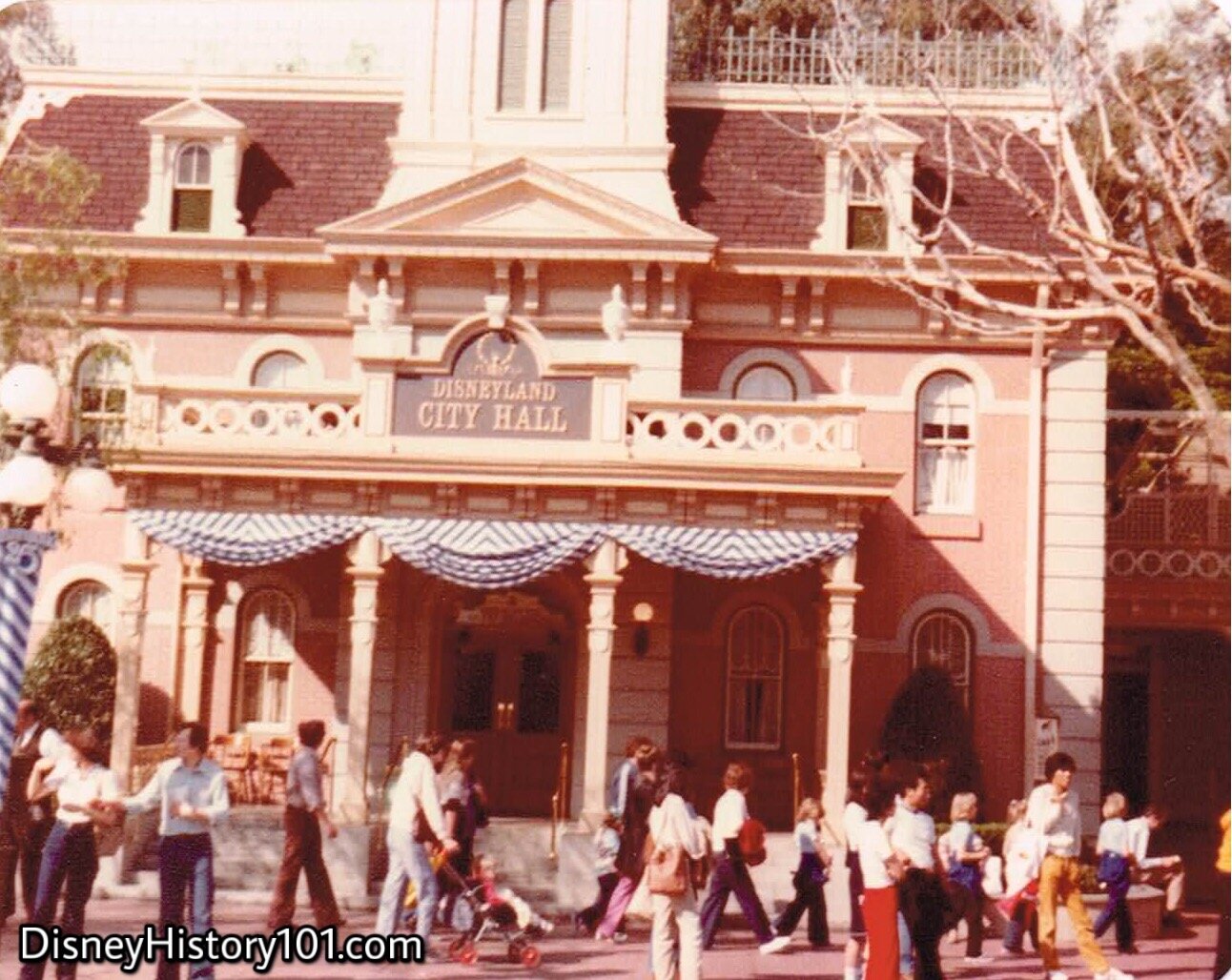
Disneyland City Hall Architectural Facade, 1980.
Blue and silver bunting decorates the Disneyland City Hall in honor of Disneyland’s 25th Silver Anniversary!

Disneyland Main Street Police Department Building, (the present)

Disneyland Main Street Police Department Building, (the present)
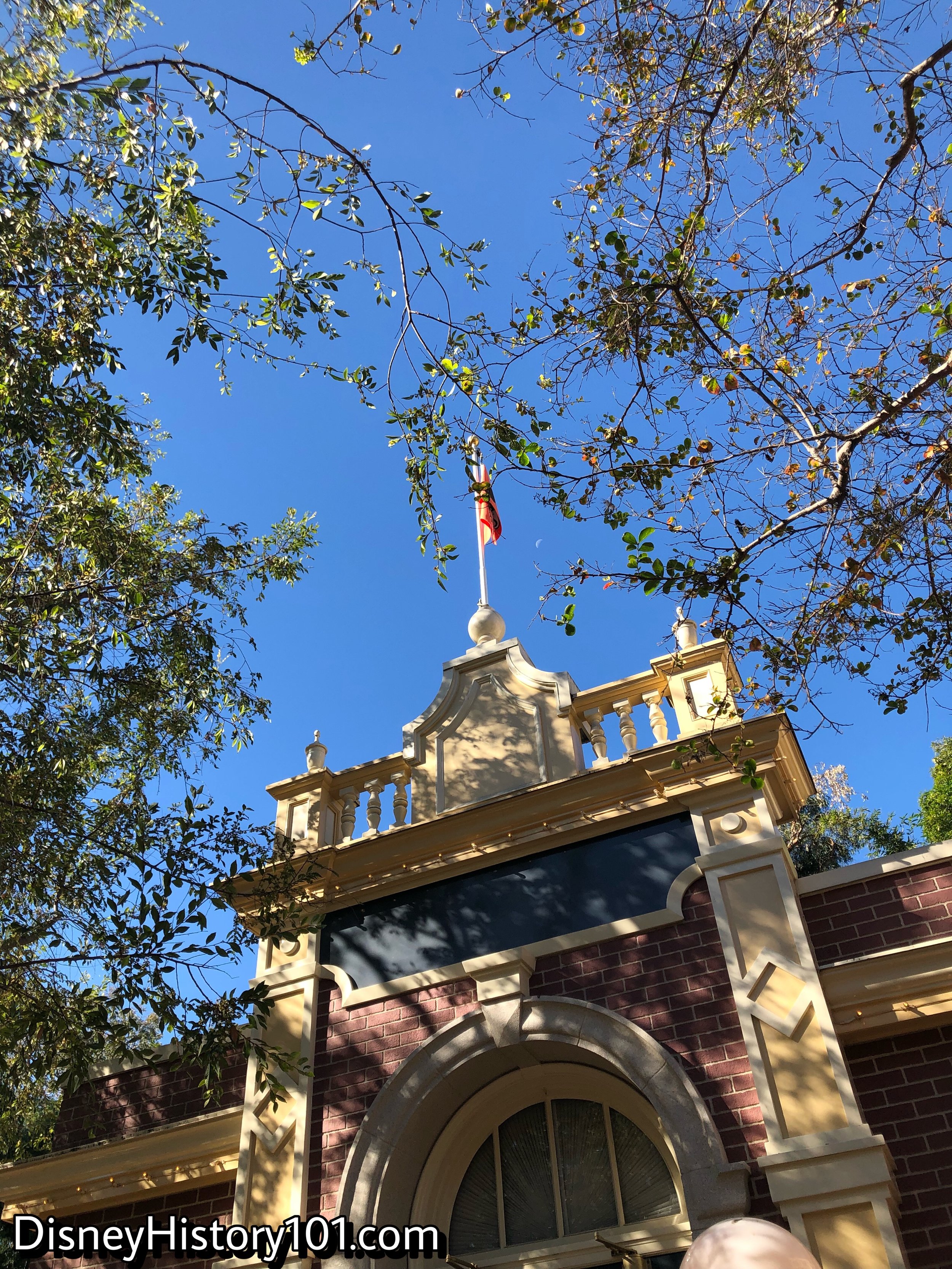
Disneyland Main Street Police Department Building, (the present)
One of five 45-star flags in Disneyland flies atop Main Street City Hall, while one of the official Flag of Disneyland flies atop the adjoining structure (the old Police Department).

Disneyland Main Street Police Department Building window (Harrison 'Buzz' Price), the present
“The Harrison Buzz Price Window”
“We celebrate our people for the memories they created in the past.” Martin Sklar once said “an individual's contribution can usually be found in the final product if one looks closely enough, but the Disney mind frame is to never point out ‘what I did’ to anyone.” However, a few outstanding individuals have been publicly recognized for their contributions and even ceremoniously honored by the Company.
There are thousands of windows at Disneyland.
Who was Harrison “Buzz” Price? Back in April of 1953, a company called Stanford Research Institute was hired by Walt, to began analysis on a suitable and sizable plot of land that had the potential to hold his “Disneylandia.”
You’ll note that the window (above) describes Harrison Price as a “finder,” and that’s because both Cornelius Vanderbilt Wood and Harrison Price (Stanford Research Institute mechanical engineers) helped “find” 10 potential Southern California locations for Walt Disney’s “Magic Kingdom.” Of these suggestions, Walt and these engineers of Stanford Research Institute decided upon a certain rural area in the Ball Road Subdivision of Orange County. This an the agricultural community (located just down the country road from the little Witherill farm), the “right” spot to realize Disneyland!
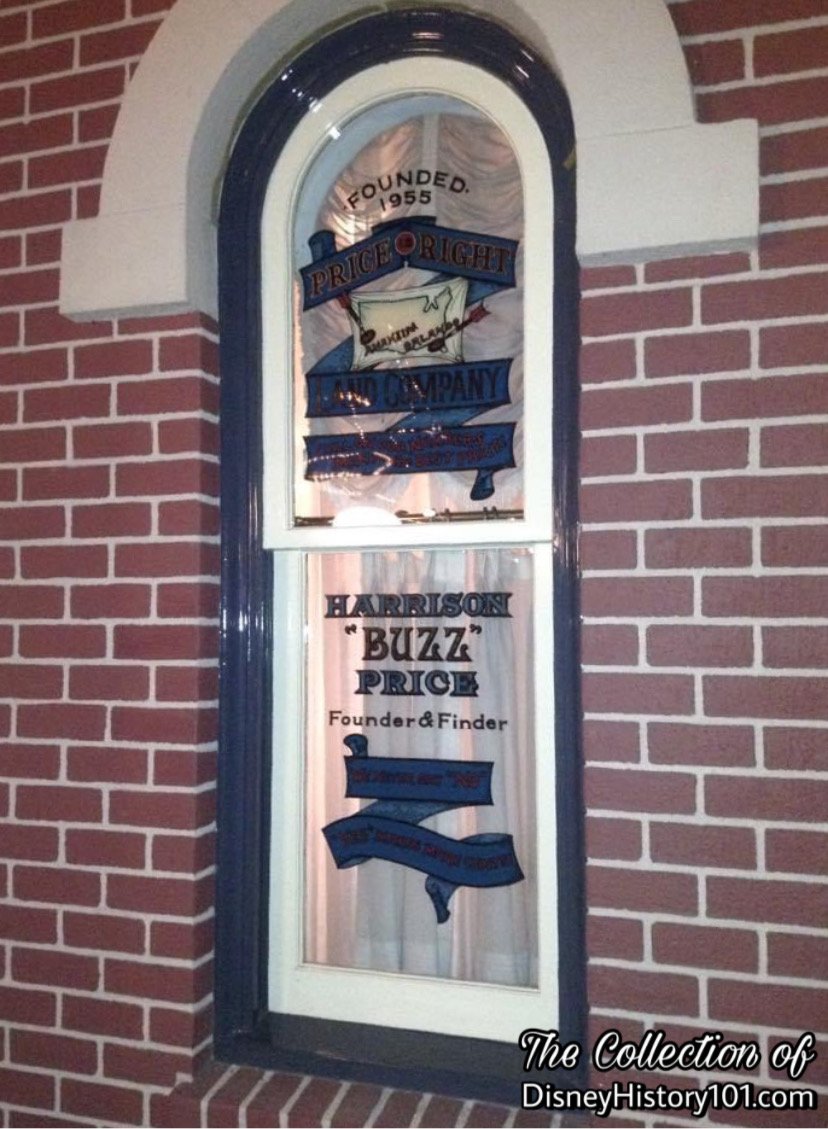
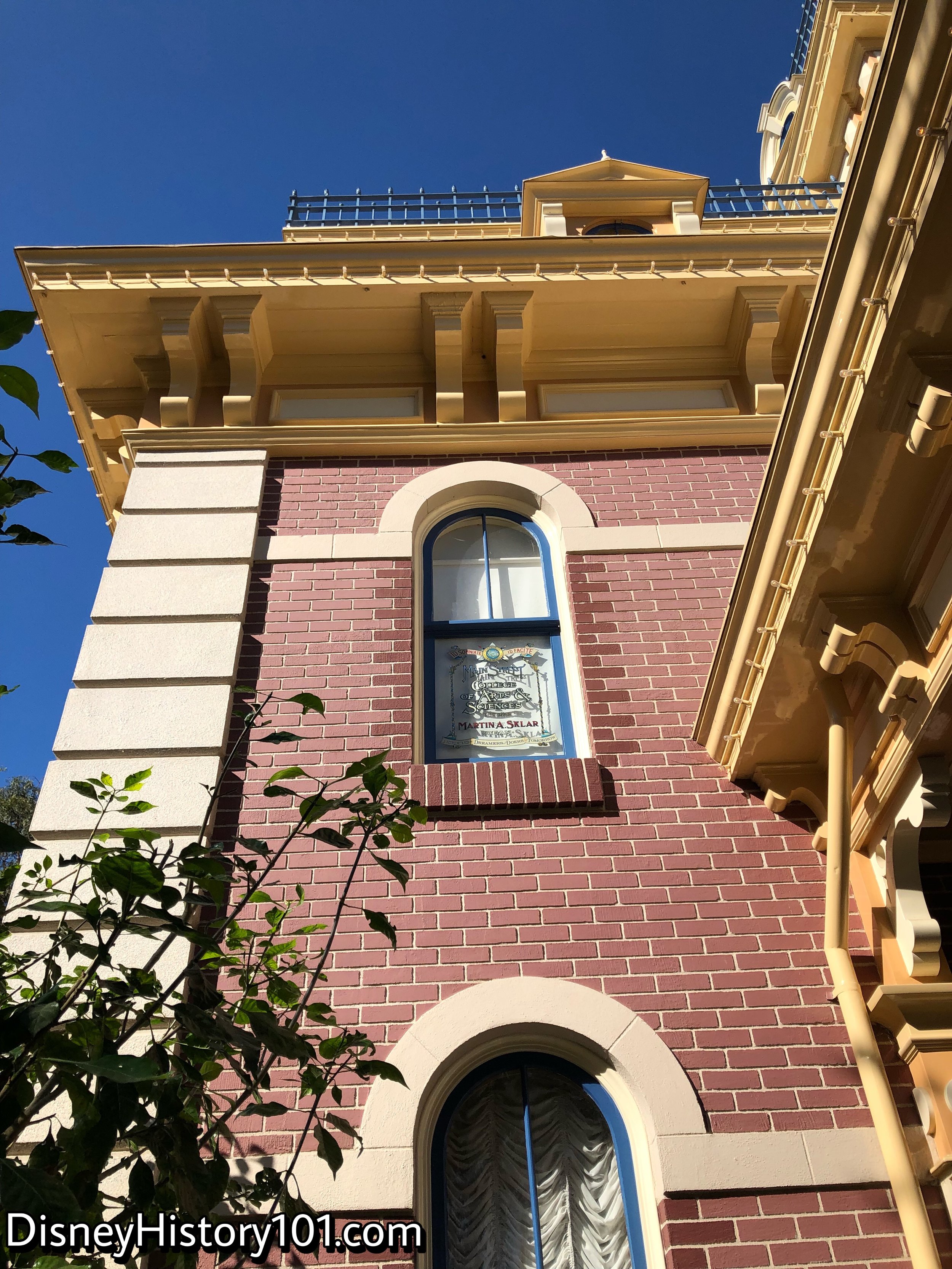
Disneyland Main Street City Hall Architectural Facade and window, (the present)
Jack Lindquist is the honorary mayor of Disneyland. Jack was the 1st president of Disneyland (announced at an awards banquet in 1989) and has a window above City Hall.
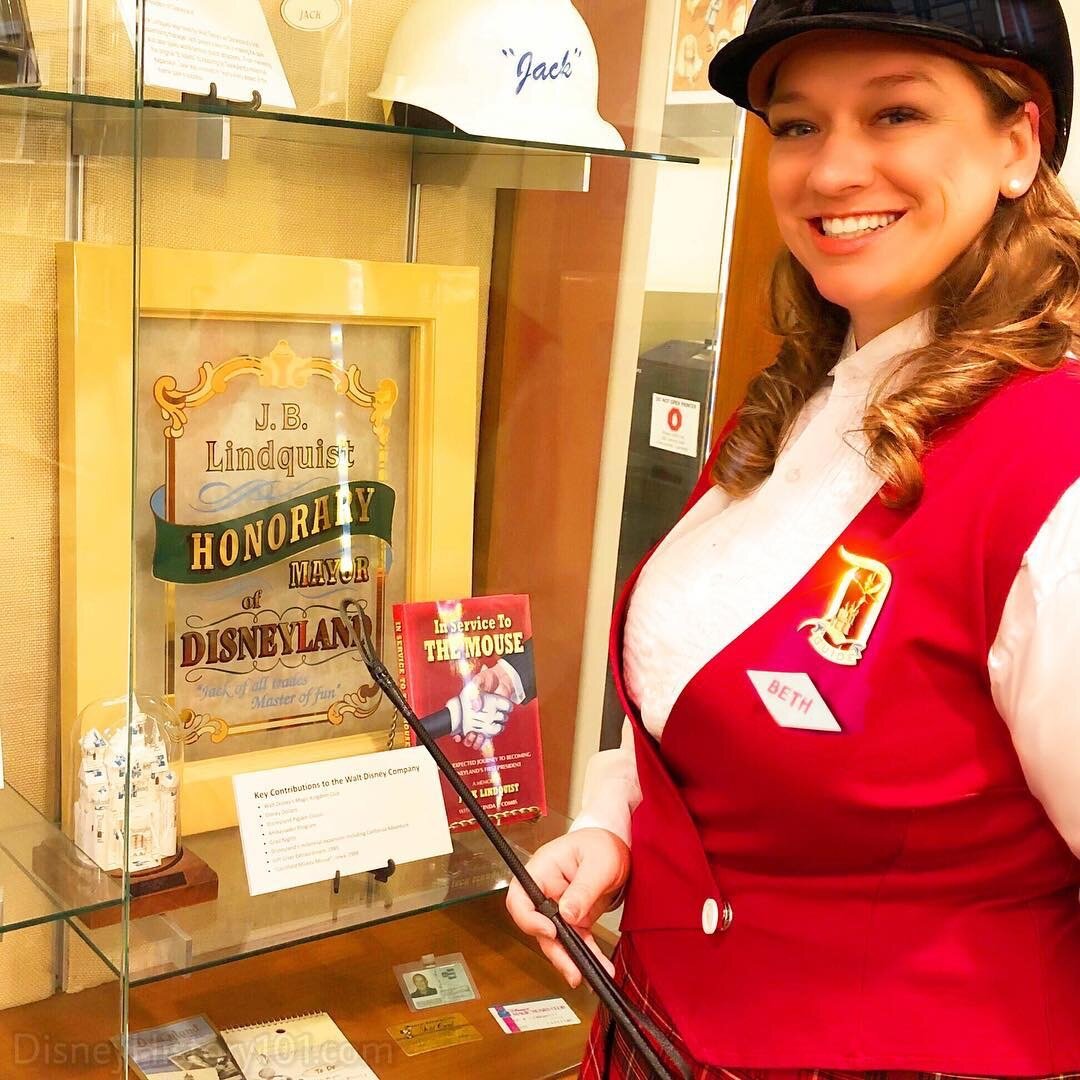
Jack Lindquist Trophy window, "Lindquist Collection", Leatherby Libraries
Not far from Disneyland, we find a special artifact among a particular library’s rotating collection. It is the trophy reproduction of the Honorary Main Street Window belonging to the first Disneyland President Jack Lindquist (1989-1994). Jack retired from Disneyland during Mickey Mouse’s 65th Birthday, and received an honorary window on Main Street U.S.A., within the Court House. The gold leaf reads, “Honorary Mayor of Disneyland”. Jack had come far from his position spearheading Disneyland’s Marketing Department, back in 1955. For all his contributions, he would soon be named a Disney Legend (in 1994), and in later years would go on to perform much altruistic and charitable work as a Trustee with the local Chapman University.

Today City Hall houses Guest Relations offices - the department that handles Guest concerns, compliments and tour services while Guests are visiting the park.
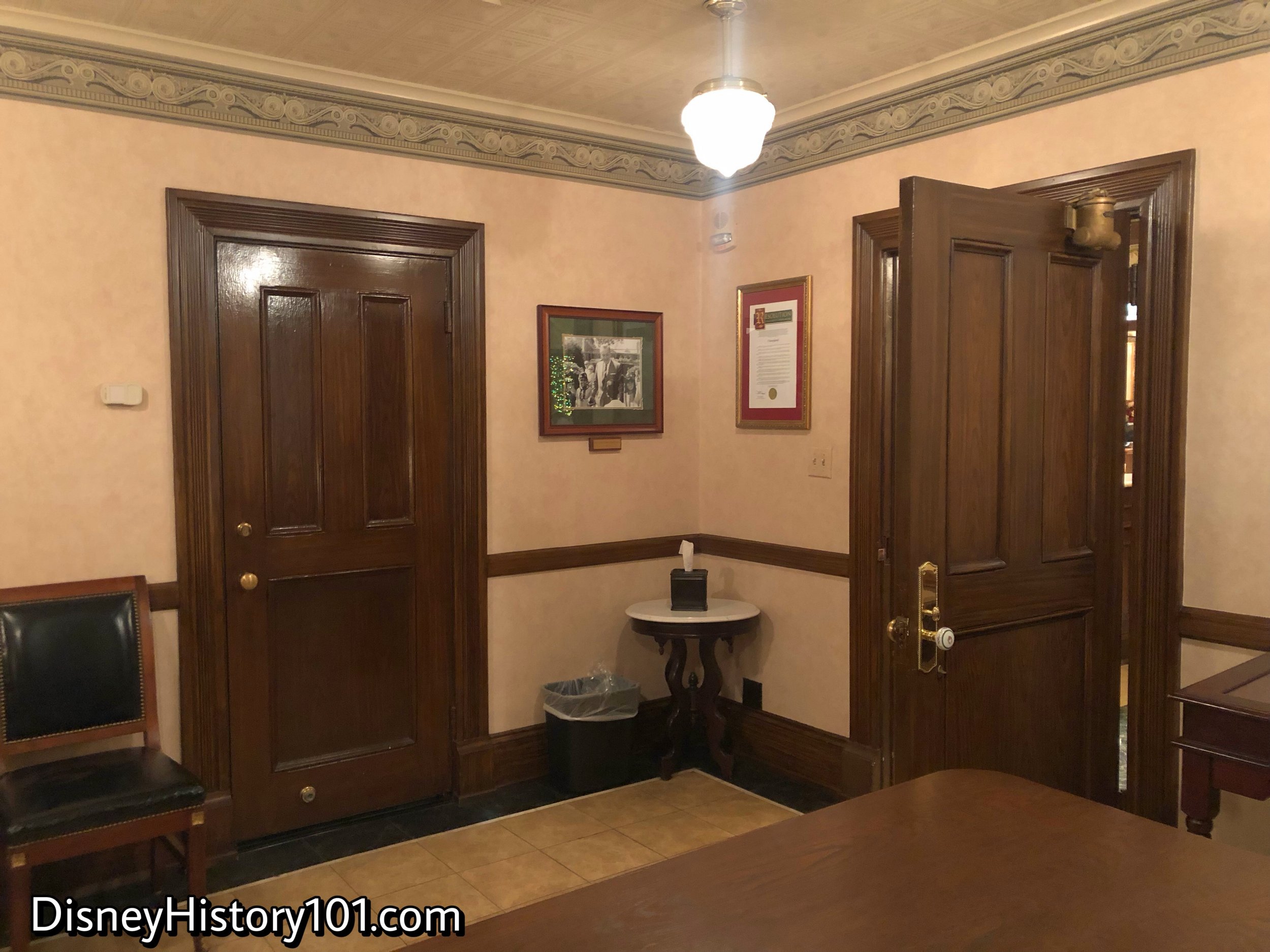
Disneyland Main Street City Hall "Mayor's Office" Interior, (the present)
The Disneyland Main Street City Hall "Mayor's Office" was once (originally) the setting of the Disneyland Police Station.

Disneyland Main Street City Hall "Mayor's Office" Interior, (the present)

Disneyland Main Street City Hall "Mayor's Office" Interior, (the present)
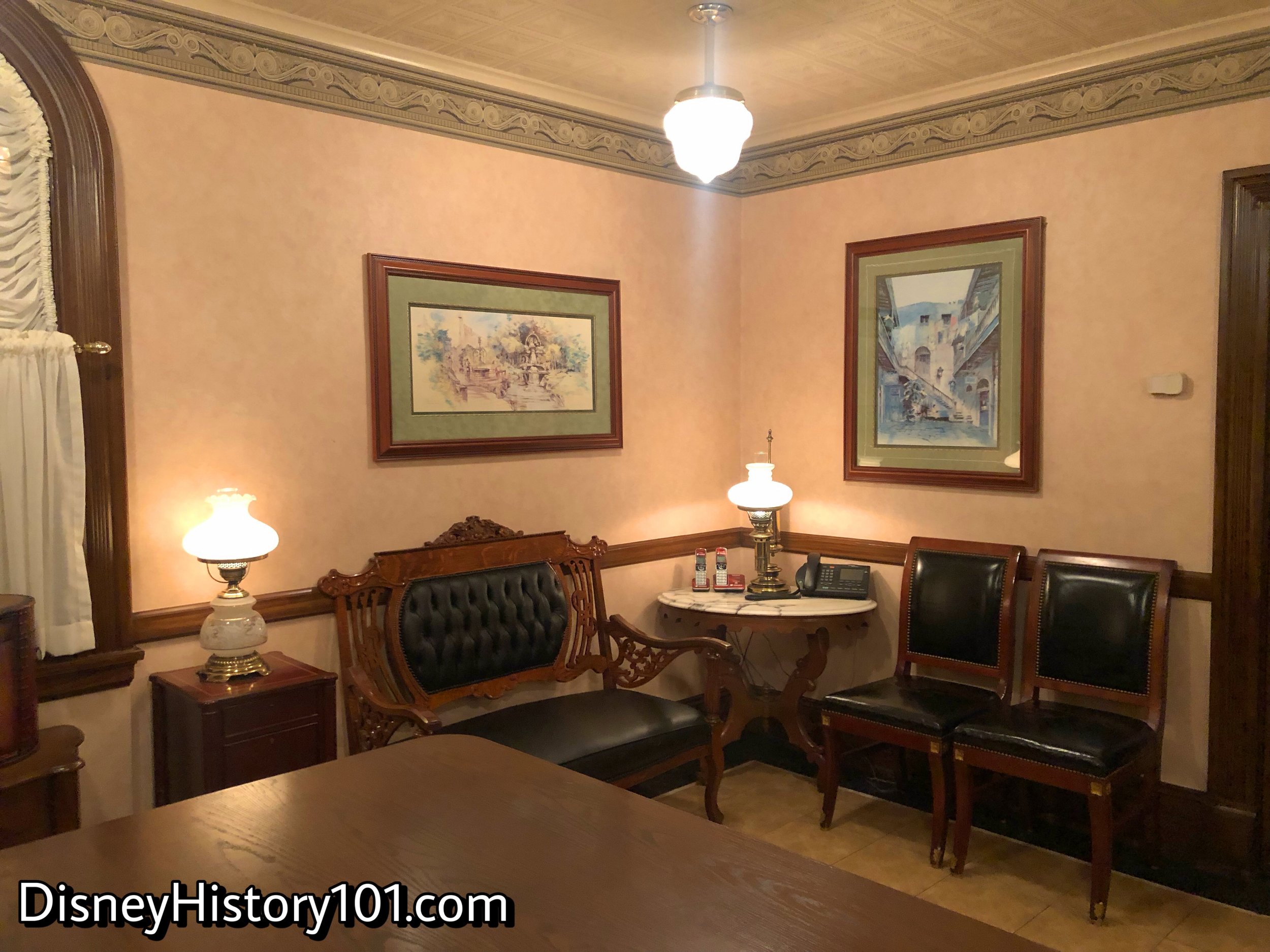
Disneyland Main Street City Hall "Mayor's Office" Interior, (the present)
In the rooms and along the exterior of the building, note the two separate types of lighting: Character lighting, and Functional Lighting. Character lighting such as a chandelier or kerosene lamp, was themed to enhance the overall appearance and complement the interior. These add to the show, but didn’t necessarily create enough illumination for operation. Functional lighting on the other hand, offers substantial light without being obvious, or distracting from the show.

Disneyland Main Street City Hall "Mayor's Office" Interior, (the present)
By late 2022, the location has become the Disneyland Merchant’s Guild.

By 1996, City Hall was still offering Guest Relations assistance. While being assisted, it may have been easy to overlook little details surrounding guests.
Inside of City Hall you may notice a bookcase, filled with books like “Walt & You,” by Sidejas and Kimbrell. The book is homage to Ray Sidejas (one-time Disneyland Custodial Guest Services Manager) and Bruce Kimbrell (one-time Disney Institute business program facilitator). The former Walt Disney Imagineering Principal Creative Executive Marty Sklar would probably agree that the small details like these make the story appealing.

The rear of City Hall serves as a Cast Member Assembly Area for Cast Members of Adventureland/Frontierland/West side of Main Street.

“Awards on Display”
By 1965, several resolutions of special recognition were being received by Walt Disney and Disneyland. By that year, resolutions had been received from the Los Angeles County Board of Supervisors and the City of Anaheim. Many other such commendations would be received before the conclusion of the Tencennial Year on a national, state and community level.
By the mid 1960s Disneyland City Hall displayed “several of Walt Disney’s international awards,” according to the “Disneyland Dictionary” (compiled by WED Enterprises, Inc. and WED Public Relations Department, c. 1968). This tradition would continue well beyond Walt’s lifetime. In the present, Disneyland City Hall still holds :
A County of Los Angeles Document recognizing the Disneyland Tencennial Celebration.
A Resolution (by the Senate, California Legislature) No. 335 - for Walt Disney Appreciation Day, unanimously adopted July 13, 1967.
A (March 4, 1980) signed resolution representing the Motion (by the County of Orange County Board of Supervisors) to wish Disneyland a Happy (25th) Silver Anniversary.

A (June 20, 1980) signed resolution (by Tom Bradley, Council President, and 15 District Members) representing the motion (by the Los Angeles City Council) to wish Disneyland a Happy (25th) Silver Anniversary.
A Resolution (by the Senate, California Legislature) recognizing the 30th Anniversary of Disneyland.
Years later, the facility would be home to the Guest Research Department.
The “I Have an Idea” Program (est. 1978) would come to yield many ideas that would influence and shape the efficiency and safety of how things were run. For instance, Disneyland Cast Member Margaret Hebenstreit had the idea to “have Disney cartoons at Lost Children to entertain children who are waiting to be found.” [Disneyland Line, March 1st, 1979]
In the present, Disneyland City Hall still cares for lost children of Disneyland.

Disneyland Honorary Citizen Certificate, 1988.
City Hall also created tangible memories Guests through merchandise and show.

Disneyland City Hall ceramic figure.

Disneyland City Hall Doors, 1955
“Legacy”
Many rehabilitations have both maintained and improved upon the show quality of backstage and onstage areas of Disneyland City Hall. For instance, one rehabilitation included Job #032-50-52 - the c.1959 installation of fifteen 48” fluorescent ceiling fixtures on the second floor, at a cost of $995.66.
Another rehabilitation involved the removal of the original Disneyland City Hall doors which were installed in 1955. After fulfilling a starring role for decades, they were salvaged during a refurbishment. Perhaps you entered through these doors in order to make use of the public telephones, or inquire of Lost Children and be reunited with them. Maybe, you even walked through these doors on your way to Disneyland Guest Relations, Disneyland Operations or the Disneyland Publicity Office. While interacting with any of these departments, you may not have noticed the doors were not full-scale.

The "aged and grained" doors of Disneyland City Hall.
Like the rest of Disneyland City Hall, they were constructed at a charming 5/8th scale. It’s also not easy to see that these amazing doors were also “Aged and Grained” with a simulated wood grain.

Today, City Hall is “Guest Relations’ central information source, located in Town Square on Main Street, U.S.A.”
Disneyland City Hall has legacy among Disney Parks worldwide. Why, by the spring of 2003, “City Hall… home to Guest Relations… on the South side of Town Square” was among the concepts for Hong Kong Disneyland. There, guests could “obtain information, ask questions, leave messages and find guidebooks in Chinese-Traditional, Chinese-Simplified, English and other languages.” It would also become “the location for Lost & Found, where guests can inquire about items they have lost during their day in the Park.”
